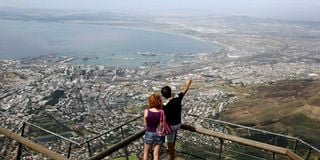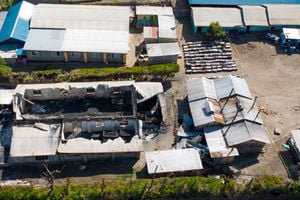Cape Town beats Johannesburg as South Africa tourism rebounds

A couple enjoys the view over the city of Cape Town from the top of Table Mountain, one of South Africa's biggest tourist attractions, on December 5, 2009.
What you need to know:
- South Africa's vital tourism industry, nearly destroyed by travel bans and Covid lockdowns, is recovering – but in a very uneven way.
- Johannesburg, the 'New York of Africa' and once the first stop for most foreign visitors, has become increasingly unpopular, while Cape Town has emerged as a leading resort destination for both locals and international visitors.
- Tourism plays a key role in the South African economy, and its post-Covid recovery may be an indicator of what other choice destinations in Africa, particularly East Africa, can expect.
South Africa's crippled tourism sector, which came close to total collapse during the height of the Covid pandemic in 2020 and 2021 as a result of lockdowns and travel bans, is recovering -- but very unevenly.
Cape Town, which along with Johannesburg and Durban on the Indian Ocean coast, has always been in the top three for visitor arrivals, has emerged from the global travel and tourism disruptions of the past nearly four years as the top destination for foreign tourists.
During the current season, which is now at its peak, Cape Town has seen more visitors than ever before, surpassing pre-Covid levels for the first time and returning to the growth trajectory it has enjoyed since the dawn of democracy in South Africa in 1994.
According to tourism officials in the "Mother City", as Cape Town is often called, there is unprecedented interest from European visitors in particular, but also from the Far East, particularly China, as well as other parts of Africa, notably the East African region.
The increase in domestic and international flights to Cape Town has boosted arrivals, with 31,000 passengers a day passing through the city's airport due to the increased number of domestic and international flights now available.
More direct flights, especially to and from East Africa, have helped to increase the number of African visitors to Cape Town. A tourism-oriented infrastructure, aided by South Africa's weakened currency, which has made the country much cheaper for dollar and euro holders, has also improved the city's overall appeal.
This has helped to push Cape Town into the 'Triple A' category in terms of what it has to offer visitors, with the famous Cape Winelands on its doorstep and as a gateway to some of the country's many high-end private game reserves in the hinterland.

Tourists watch and take pictures of African penguins, also known as Black-footed Penguin, at Table Mountain National Park in South Africa, on July 4, 2010.
Cape Town's outstanding conference and exhibition facilities, as well as its ability to host major international sporting events, also help it to shine as a destination.
A recent example was the 2023 Netball World Cup, the four-yearly premier international competition for the sport, which was held at the Cape Town International Convention Centre in July and August last year -- a first for the sport in Africa.
But Cape Town's growing international popularity – also among South Africans, especially from the Johannesburg metropolitan area – has come at the expense of other previously popular tourist destinations, such as coastal cities like Nelson Mandela Bay in the Eastern Cape and KwaZulu-Natal's famous Durban, with its warm waters, balmy weather and numerous once-pristine sandy beaches.
Today, these places have been largely abandoned by foreigners, who instead tend to begin or end their visits to far-flung South Africa in the Mother City, which is widely regarded as one of the most visually attractive locations in the world.
Indeed, the city is also emerging as a hub for film and television production, with a dedicated film set and production facility just 20km from the city centre, and a host of experienced local media professionals, offering producers easy options and great visual backdrops, all at relatively low cost.
Increasingly cut out of the international tourism business, Durban, Johannesburg and other locations have instead shifted their post-Covid focus to attracting local tourism as a replacement, which in Durban's case is partially working but is also much less lucrative.
This pattern appears to be similar to other regions, including East Africa, which before the pandemic had become increasingly dependent on tourism as a major contributor to the local economy.
Part of what is deterring visitors to Johannesburg in particular is the country's ongoing struggle with high levels of crime.
A significant number of foreign -- and even local -- visitors have been targeted by criminal gangs on arrival for mugging, car hijacking or armed robbery, further eroding Johannesburg's reputation and appeal.
Parts of Johannesburg's inner city have been redeveloped, but other areas are in deep urban decay and are particularly dangerous for non-locals.
The sprawling metropolis was once the usual first stop for some foreigners who came to soak up the atmosphere, Afro-jazz music and unique cuisine of Soweto's 'township culture', as well as to visit notable sites such as Nelson Mandela's home or the Cradle of Humankind, a Unesco palaeoanthropological World Heritage Site about 50km north-west of Johannesburg, where extraordinary early hominid remains have been found in abundance.
Johannesburg was also seen as a convenient jumping off point for those drawn from afar by Africa's wildlife, in particular the Kruger National Park, one of Africa's largest game and nature reserves, which has been expanded in recent years to become a major cross-border attraction.
Overall, South Africa's tourism baseline for 2019, according to the annual Tourism Satellite Account (TSA) report, which draws on a wide range of data sources, shows that a clear recovery path has been established in the wake of Covid.
The report assesses a number of indicators, including national accounts, international and domestic visitor surveys, visitor arrival statistics, tourist accommodation data and figures from the restaurant, fast food and catering industry, which together provide a rich source of data.

Black-tip sharks swimming during a baited shark dive in Umkomaas near Durban, South Africa, on December 10, 2020.
According to the TSA, the tourism sector contributed 3.7 per cent to SA's total gross domestic product (GDP) in 2019.
Compared to other sectors, tourism in South Africa is larger than agriculture, utilities (electricity, gas and water combined) and construction.
Tourism activity and expenditure directly contributed $11.2 billion to the national fiscus in 2019, with the fast-growing sector directly employing 4.7 per cent of the total formal workforce. At the time, 773,533 people were working in this part of the formal sector, translating to about 1 in every 21 employed individuals.
With unemployment still well above 30 per cent – and around double that for younger jobseekers – the recovery of the tourism sector, albeit reformulated, bodes well for the economy as a whole.
The sector's recovery and continued growth are seen by economic commentators as both necessary to South Africa's much-needed economic turnaround and a key indicator of the speed of that turnaround.
Aside from what it all means for South Africans, who have had a torrid time, with power cuts becoming routine on top of years of pre-Covid economic weakness linked to widespread corruption, tourism operators believe that the pattern of the country's partial and patchy 'recovery' may well be an indicator of expectations for other tourism-dependent economies in Africa.





